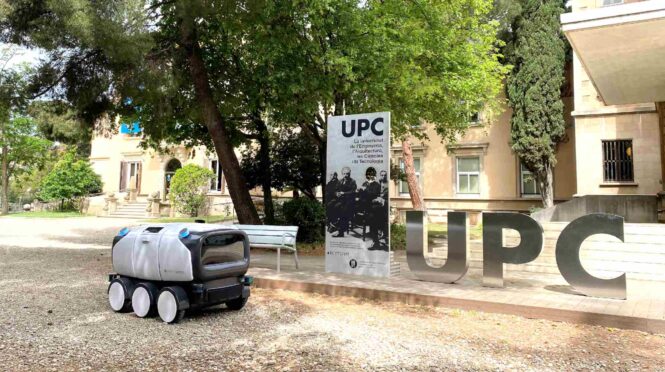
From BusinessInsider Feb 7, 2022
Excerpt
In a few years, it will probably be pretty ordinary to see robots delivering packages and transporting goods in cities.
Delivery companies are always on the lookout for the next big innovation in the sector.
In the US, companies like Starship Technologies have seen huge growth as a result of the pandemic, and others like Coco are also scaling quickly.
Some big names have also developed their own autonomous delivery robots, like Alibaba, whose robots are becoming ever more prominent in daily life in China.
Many companies have already launched their first prototypes, but the robots developed by the Polytechnic University of Catalonia (UPC) and CARNET have a standout feature — they’re able to go up and down stairs, according to the press release.
Text From Press Release
The objective of the ADD project is to analyze how autonomous delivery devices can improve the urban distribution of goods as a whole, quantify the potential impacts and test them in real city environments. The distribution of products in metropolitan areas has increased in recent years in absolute values, frequencies and quality requirements.
In the future, the growth of e-commerce and the new characteristics of supply chains (just in time, zero stock, delivery in increasingly tight time slots) will also put even more pressure on the physical distribution of goods in busy urban areas.
From the perspective of the city, the urban distribution of goods generates several negative effects, worsening the habitability of urban areas in terms of congestion, air quality, noise nuisance, public land use and pavement deterioration. Episodes of urban congestion, the scarcity of parking spaces for loading/unloading commercial vehicles and local regulations mean that the management of urban distribution of goods has a very high cost for logistics companies. It is estimated that the costs of the last mile (the last leg of the supply chain between the distribution center and the final customer) represent up to 40% of the total transport costs or more than 20% of the pollution in cities . The deployment of autonomous vehicles would entail a significant reallocation of carrier costs and would make the service more economical and efficient than with conventional vehicles. In fact, these vehicles can work at low hours or even at night, when there is less congestion. In this sense, many companies are already introducing autonomous delivery robots (ADD) to the market with the aim of reducing operating costs.
Although some autonomous delivery services are being tested in public environments, these initiatives are clearly in the minority and most of the pilots are currently deployed in controlled environments. In this context, the Universitat Politècnica de Catalunya BarcelonaTech (UPC) and CARNET –the future mobility research hub, coordinated by the Center for Innovation and Technology (CIT-UPC), have designed and manufactured an appropriate ADD prototype to move in urban environments. CARNET, founded by the University, VW Group Research and SEAT in 2014, has fifteen industrial partners.
The ADD prototype, designed under the coordination of CARNET, was presented for the first time on December 16, at a meeting of industrial partners that took place in the UPC rectorate. The autonomous vehicle travels at a maximum speed of 20 km/h, measures 170 cm x 110 cm x 100 cm, has six wheels and can go up or down steps up to 20 cm high. The ADD project began in 2017 with the ‘Logistic Service’ study, developed by the Higher Technical School of Engineering of Roads, Canals and Ports of Barcelona (ETSECCPB) of the UPC, where the logistics service with ADD was conceptualized, the needs of the vehicle and the potentialities and impacts of autonomous robots were analyzed. In 2019, different studies were carried out on the second uses that these vehicles can have. It was concluded that the ADD, in addition to the distribution tasks, could analyze the quality of the pavement or the air thanks to the data that comes from the vehicle’s sensors, together with a computer vision algorithm.
